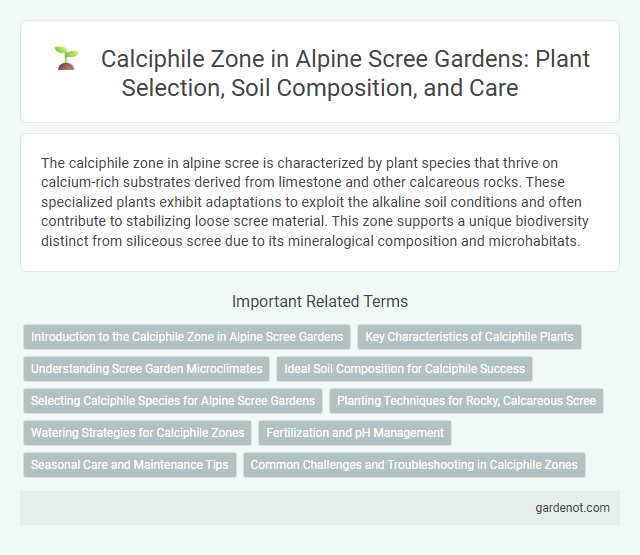The calciphile zone in alpine scree is characterized by plant species that thrive on calcium-rich substrates derived from limestone and other calcareous rocks. These specialized plants exhibit adaptations to exploit the alkaline soil conditions and often contribute to stabilizing loose scree material. This zone supports a unique biodiversity distinct from siliceous scree due to its mineralogical composition and microhabitats.
Introduction to the Calciphile Zone in Alpine Scree Gardens
Calciphile zones in alpine scree gardens showcase plants that thrive on calcium-rich substrates, often derived from limestone or other calcareous rocks. These specialized plants exhibit adaptations for nutrient uptake in alkaline, well-drained soils typical of high-altitude scree environments. Understanding the calciphile zone highlights the biodiversity and ecological niche specialization crucial for alpine garden design and conservation efforts.
Key Characteristics of Calciphile Plants
Calciphile plants in alpine scree environments thrive on calcium-rich, alkaline soils with high pH levels, often derived from limestone or chalk substrates. These plants exhibit specialized root systems capable of extracting nutrients from rocky, nutrient-poor terrain and display adaptations like drought resistance and tolerance to temperature fluctuations. Species such as Saxifraga and Primula demonstrate calciphile traits, promoting biodiversity in calciphilic zones by stabilizing scree and supporting microhabitats.
Understanding Scree Garden Microclimates
The Calciphile zone in Alpine scree hosts specialized plant communities thriving on calcium-rich, well-drained substrates shaped by limestone geology. Microclimates within scree gardens vary drastically due to sun exposure, wind patterns, and soil composition, influencing moisture retention and temperature fluctuations critical for calciphile species survival. Understanding these microclimatic conditions helps predict plant distribution and supports conservation efforts for fragile alpine ecosystems dependent on calcium-rich scree environments.
Ideal Soil Composition for Calciphile Success
Calciphile plants in alpine scree thrive best in soils rich in calcium carbonate, often derived from limestone or dolomite parent rock. The ideal soil composition includes well-drained, alkaline substrates with a pH typically ranging from 7.5 to 8.5, providing essential calcium ions for nutrient uptake. Enhanced soil aeration and a balance of coarse mineral particles support root penetration and moisture retention critical for calciphile adaptation.
Selecting Calciphile Species for Alpine Scree Gardens
Choosing calciphile species for alpine scree gardens requires understanding their preference for calcium-rich, well-drained soils typical of the calciphile zone. Species such as Saxifraga paniculata, Campanula cochleariifolia, and Aster alpinus thrive in these conditions, providing resilience and aesthetic appeal. Incorporating native calciphiles enhances biodiversity while ensuring plants adapt to the harsh, nutrient-specific environment of alpine scree habitats.
Planting Techniques for Rocky, Calcareous Scree
Planting techniques for rocky, calcareous scree in the calciphile zone emphasize selecting species adapted to high pH soils rich in calcium carbonate, such as Dianthus, Saxifraga, and Campanula. Optimal establishment involves using well-drained, coarse substrates that mimic natural scree conditions, facilitating root penetration and preventing waterlogging. Micro-topography creation promotes moisture retention and protection from wind erosion, supporting plant survival in harsh alpine environments.
Watering Strategies for Calciphile Zones
Effective watering strategies for calciphile zones in alpine scree emphasize maintaining moderate moisture without oversaturation, as these plants thrive in well-drained, calcium-rich soils. Deep, infrequent watering encourages root penetration and reduces the risk of fungal diseases common in high-calcium environments. Employing drip irrigation or targeted watering techniques helps preserve soil structure and supports the specialized nutrient uptake of calciphile alpine flora.
Fertilization and pH Management
In the calciphile zone of alpine scree, soil fertilization must emphasize calcium-rich amendments to support calciphilous plant species adapted to high pH environments, typically ranging from pH 7.5 to 8.5. Maintaining alkaline soil conditions through lime application or calcium carbonate supplementation enhances nutrient availability, particularly magnesium and potassium, critical for plant growth in these nutrient-poor substrates. Precise pH management prevents acidification, which can disrupt microbial communities and reduce calciphile vegetation diversity essential for ecosystem stability.
Seasonal Care and Maintenance Tips
Seasonal care in the calciphile zone of Alpine scree requires monitoring soil pH to maintain its high calcium content, crucial for plant health. Regular removal of debris and managing moisture levels prevent root rot during wet seasons and dehydration in dry months. Adjust watering schedules based on seasonal precipitation patterns to support calciphile species adapted to alkaline, rocky substrates.
Common Challenges and Troubleshooting in Calciphile Zones
In alpine scree within calciphile zones, soil alkalinity and limited nutrient availability often hinder plant establishment and growth. Plants must adapt to high pH levels and fluctuating moisture conditions, which can cause root stress and reduced nutrient uptake. Managing these challenges requires selecting calciphile species with specialized root systems and implementing soil amendments to optimize calcium availability and soil structure.
Calciphile zone Infographic

 gardenot.com
gardenot.com